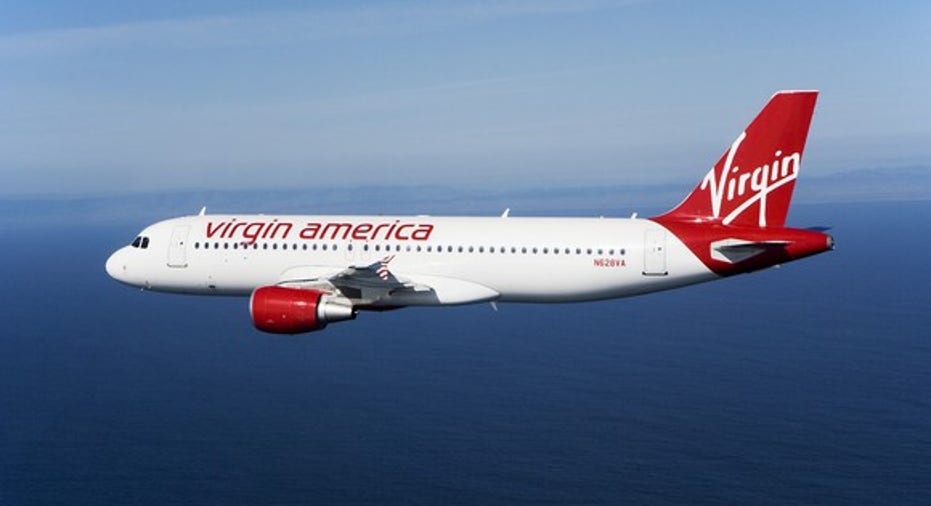Virgin America Profit Soars as It Waits to Merge With Alaska Air

Virgin America (NASDAQ: VA) may be nearing the end of its run as an independent company, assuming Alaska Air (NYSE: ALK) can satisfy antitrust regulators that combining the two carriers would not harm competition. If so, it's going out with a bang.
Alaska Air and Virgin America hope to complete their merger soon. Image source: Alaska Airlines.
On Wednesday afternoon, Virgin America reported strong earnings growth for Q3, driven by a sharp reduction in its unit costs. This is good news for Alaska Air, validating its decision to pay a hefty sum for Virgin America.
Q3 earnings crush forecasts
Virgin America was one of the few U.S. airlines to grow its net income and operating margin last quarter. Earnings per share reached $1.19, excluding $0.04 of merger-related costs, blowing by the average analyst estimate of $1.01. Virgin America's adjusted operating margin increased to 20.7%, up from 18.2% in Q3 2015.
Virgin America's unit revenue trajectory didn't improve last quarter. Revenue per available seat mile fell 7.2% year over year, roughly in line with its Q2 result. However, non-fuel unit costs (excluding special items and profit sharing) decreased 5.6% year over year in Q3, compared to a 2.5% increase in the first half of the year.
Reaping the benefits of expansion
Following the earnings release, I had the opportunity to speak with Virgin America CEO David Cush and CFO Peter Hunt.
Hunt noted that Virgin America recently expanded its fleet from 53 planes in mid-2015 to 63 planes by mid-2016. During that transition period, the company incurred some extra costs related to putting these new aircraft into service and training new crews.
Virgin America has expanded its fleet significantly since mid-2015. Image source: Virgin America.
In Q3, the company finally started to realize the benefits of growth, which generally drives unit costs lower -- largely by spreading fixed costs across more seats. Virgin America increased its capacity 16.7% year over year last quarter, while nearly every expense category rose at a slower rate.
As Virgin America's fleet ages and as its growth rate moderates over the next few quarters (and years), it will probably face greater cost pressure. That said, the company also has a meaningful opportunity to further reduce its unit costs as it adds larger, more efficient A321neos to its fleet over the next two years.
Mixed trends on the revenue side
Virgin America's 7.2% unit revenue decline in Q3 was among the worst in the industry. Some of the decline was driven by the carrier's rapid capacity growth. For example, Virgin America has started four new routes to Hawaii in the past year -- and while they are performing well, unit revenue there is likely to improve further in 2017.
Lower fares on transcontinental routes have been the biggest source of unit revenue pressure for Virgin America, according to Cush. Most notably, the supply of premium seats on flights from New York to San Francisco and Los Angeles has surged since JetBlue (NASDAQ: JBLU) introduced its Mint premium product in 2014.
Cush pointed out that JetBlue has a greater than 20% share of the premium seats from New York to San Francisco and Los Angeles today, up from zero at the beginning of 2014. JetBlue has also offered lots of Mint lie-flat seats for as little as $799 one way. The combination of higher supply and pricing pressure is driving down the average fare for Virgin America's first class seats.
Virgin America has had to reduce its first class fares on some routes. Image source: Virgin America.
On the bright side, Virgin America's unit revenue at Dallas Love Field has finally started to improve after plunging in late 2014 and 2015. The Dallas focus city still isn't living up to expectations for Virgin America, but at least it is moving in the right direction.
Good news for Alaska Air
Virgin America's weak unit revenue trend is somewhat concerning, but there is a good chance that it will improve as growth slows over the next few quarters. The wild card is predicting how much JetBlue's ongoing expansion of Mint premium service to Boston and Fort Lauderdale will impact Virgin America's first class fares on its routes to those cities.
However, Virgin America showed last quarter that it can absorb some unit revenue declines by reducing its cost structure as it grows. Indeed, its Q3 profit margin was in the upper half of the U.S. airline industry.
Virgin America's strong Q3 results won't have much of an impact on its stock, as the company has already agreed to sell itself to Alaska Air for $57 per share.
Alaska Air shareholders should be pleased, though. In recent months, many analysts have suggested that Alaska may be overpaying for Virgin America, in light of the latter's unit revenue struggles and rising unit costs. Virgin America's strong Q3 results should put a damper on that kind of speculation. Alaska may not be getting a bargain, but it is acquiring a valuable asset in Virgin America for a fair price.
A secret billion-dollar stock opportunity The world's biggest tech company forgot to show you something, but a few Wall Street analysts and the Fool didn't miss a beat: There's a small company that's powering their brand-new gadgets and the coming revolution in technology. And we think its stock price has nearly unlimited room to run for early in-the-know investors! To be one of them, just click here.
Adam Levine-Weinberg owns shares of Alaska Air Group and JetBlue Airways and is long January 2017 $17 calls on JetBlue Airways. The Motley Fool has no position in any of the stocks mentioned. Try any of our Foolish newsletter services free for 30 days. We Fools may not all hold the same opinions, but we all believe that considering a diverse range of insights makes us better investors. The Motley Fool has a disclosure policy.



















